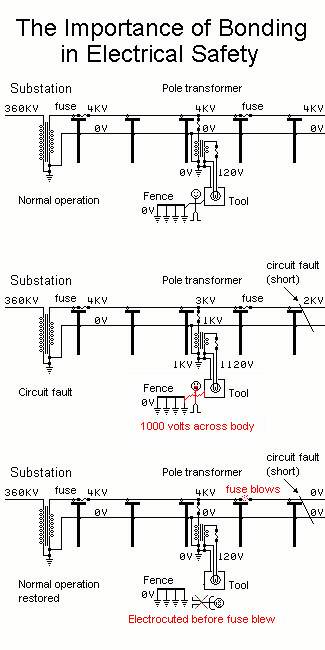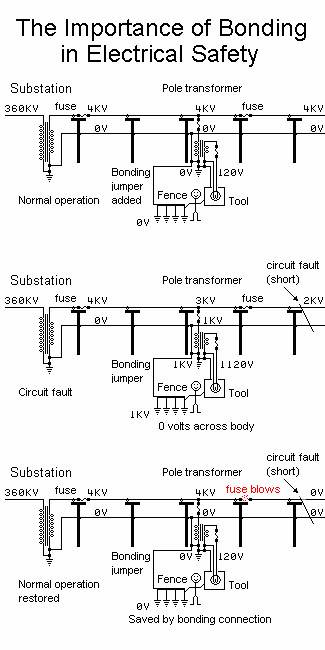UNSAFE OPERATION
Here is an example of unsafe operation. The electrical system of the house is properly connected and grounded to the earth at the service entrance. But a metal fence near the house is connected to the earth by the fenceposts, but is not bonded to the electrical system ground. Here is the sorry tale:
- Our hapless victim is sanding old paint off of the fence with a power tool.
- An accident far away from the house shorts the hot and neutral wires of the 4000-volt feeder circuit together.
- Several hundred amperes of current flow instantly. With just a few ohms of resistance in the power lines, the 4 KV is divided along the length of the wires.
- The ground of the pole transformer, house, and power tool are raised 1000 volts above earth ground by the high current and the voltage dropped on the neutral wire.
- Because the fence has NOT been raised above ground by the current, it is STILL AT GROUND POTENTIAL!
- The connection between 1000 volts on the tool, and ground on the fence, is completed by the hapless victim, electrocuting him!
- The fuse blows farther down the line, ending the current and the voltage rise of the house electrical system. Rescuers arriving at the scene have no idea why the victim was electrocuted, since no faults can be found in the electrical system or in the tool.
Many unsolved electrocutions are caused by this effect. This web page, combined with power company records, can be used to identify the cause of such fatalities. Notice that a lightning strike can produce the same effect, also far from the site of the strike.

SAFE OPERATION
Here is an example of safe operation. The electrical system of the house is properly connected and grounded to the earth at the service entrance. Here, the metal fence near the house is connected to the earth by the fenceposts, And the fence IS bonded to the electrical system ground. Here is the happier story:
- Our potential victim is sanding old paint off of the fence with a power tool.
- An accident far away from the house shorts the hot and neutral wires of the 4000-volt feeder circuit together.
- Several hundred amperes of current flow instantly. With just a few ohms of resistance in the power lines, the 4 KV is divided along the length of the wires.
- The ground of the pole transformer, house, and power tool are raised 1000 volts above earth ground by the high current and the voltage dropped on the neutral wire.
- Because the fence has is bonded to the house electrical system ground, it is also raised to the same potential.
- The connection between 1000 volts on the tool, and 1000 volts on the fence, is completed by the victim. But since both are at the same potential, no current flows through him! He is not a victim!
- The fuse blows farther down the line, ending the current and the voltage rise of the house electrical system. Rescuers do not arrive, because nothing happened to the man. He continues to work on the fence, annoyed at the brief power interruption.
Because an inexpensive #4 bonding jumper was connected between the electrical service ground and the metal fence, the man's life was saved.
